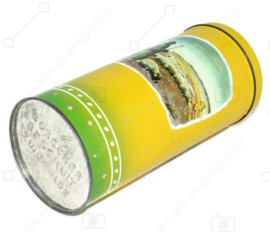SOLD
Vintage yellow-green rusk tin made by Bosscher rusk Zuidwolde
SKU: BT-3299-21Vintage yellow-green rusk tin made by Bosscher rusk Zuidwolde.
- Manufacturer: Bosscher rusk Zuidwolde
- Manufacturing date: 1970 - 1980
Description
Beautiful vintage rusk tin from Bosscher rusk Zuidwolde. This tin cylindrical biscuit tin is equipped with a loose lid. The decoration of this bus consists of a bright yellow background with green details. The tin has two images. On one side a shepherd with flock and on the other side a sheep farm. This tin has a longitudinal seam at the back.
This biscuit tin is marked at the bottom with the inscription: "Bosscher Beschuit Zuidwolde".
Condition
This tin biscuit tin is in a good vintage condition with normal traces of use and age-related traces of wear. Photos are part of the description.
Size
- Height: 22 cm.
- Diameter: 11 cm.
A rusk is a hard, dry biscuit or a twice-baked bread. It is sometimes used as a teether for babies. In some cultures, rusk is made of cake, rather than bread: this is sometimes referred to as cake rusk. In the UK, the name also refers to a wheat-based food additive.
Netherlands and Belgium (Flanders)
Beschuit, also known as Dutch crispbakes, are light, round, rather crumbly, rusks as eaten in the Netherlands and Belgium. When a baby is born in The Netherlands, it is customary to serve beschuit met muisjes (with "little mice", which are aniseeds covered in a white and pink or blue sugar layer, depending on the newborn's gender). Beschuiten are also eaten as a breakfast food with a variety of toppings, most commonly butter and sprinkles in flavours such as chocolate (chocoladehagel or chocoladevlokken) or fruit (vruchtenhagel), jam or cheese. A longtime Dutch favourite is to serve strawberries on beschuit, which is usually topped with some sugar or whipped cream.
Beschuiten are made by first baking a flat round bread (beschuitbol), slicing it in half, and then baking each half again, usually at a lower heat. It is almost always sold in rolls; a roll typically has 13 rusks (a baker's dozen). Etymologically, biscotto (16th-century Italian), biscuit (19th century, from 16th-century bisket) and beschuit come from the Latin phrase (panis) bis-coctus, (bread, twice cooked).
United Kingdom
To the British, butcher rusk is a dry biscuit broken into particles, sorted by particle size and sold to butchers and others for use as a food additive in sausage manufacture. Though originally made from stale bread, now called "bread-rusk", a yeast-free variety called simply "rusk" is now more commonly used.
Various rusk particle sizes are used in the food industry, where uses include:
A carrier for flavours, colours and seasonings
A binding agent in hamburgers, sausages, stuffings, pies, and other compound meat products
As an ingredient for dried stuffing mixes
Some translations come from an automated system and may contain errors.
Country of origin
The Netherlands - Holland
Kind of object
Rusk tin - Biscuit tin
Theme
Zuidwolde - rusk - product packaging
Decoration
Shepherd - farm
Category
Vintage tins
Color
Yellow - green - multi-coloured
Publisher
Bosscher Beschuit
Manufacturer
Bosscher Beschuit Zuidwolde
Brand
Bosscher Beschuit
Material
Tin - metal - paint
Particularities
Loose lid - marked at the bottom
Era
1970 - 1980
Quality
Good vintage condition
Height
22,00 cm
Diameter
11,00 cm
Shipping method
Parcel post with track & trace























